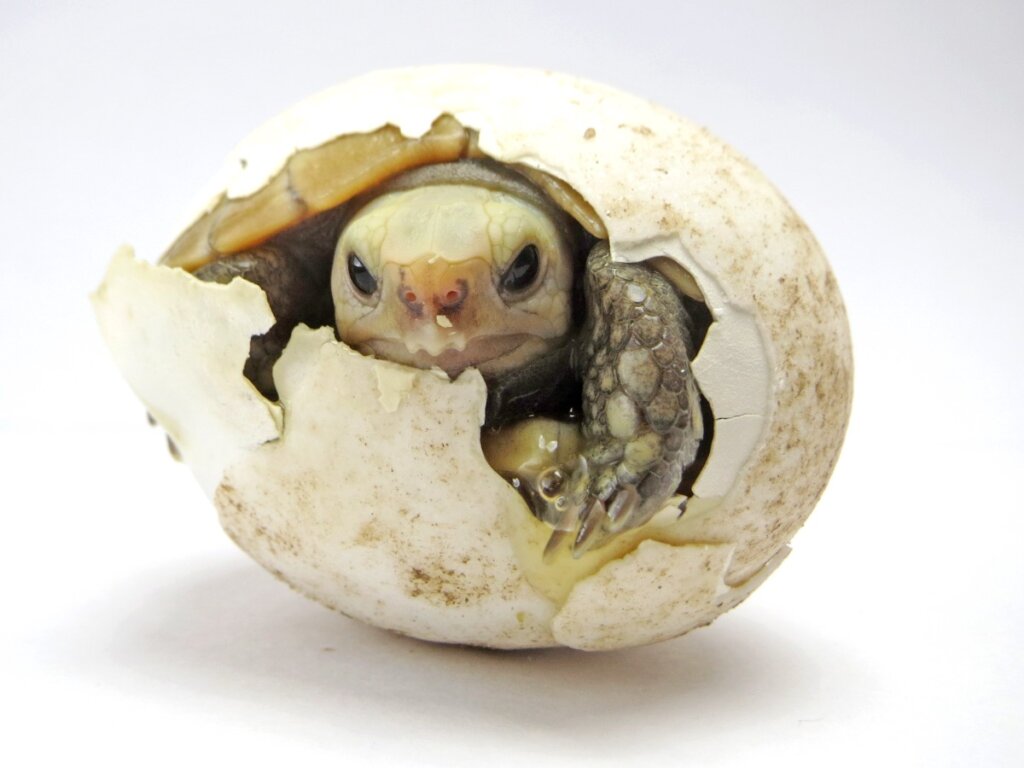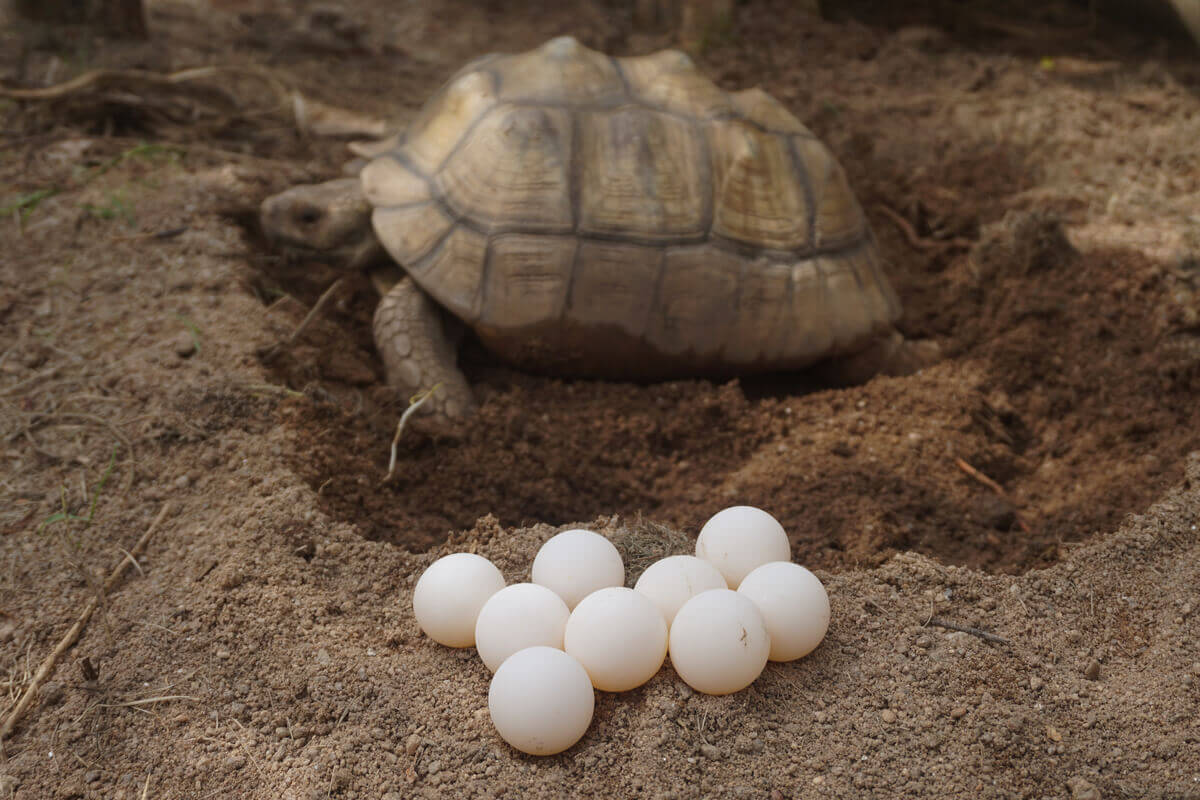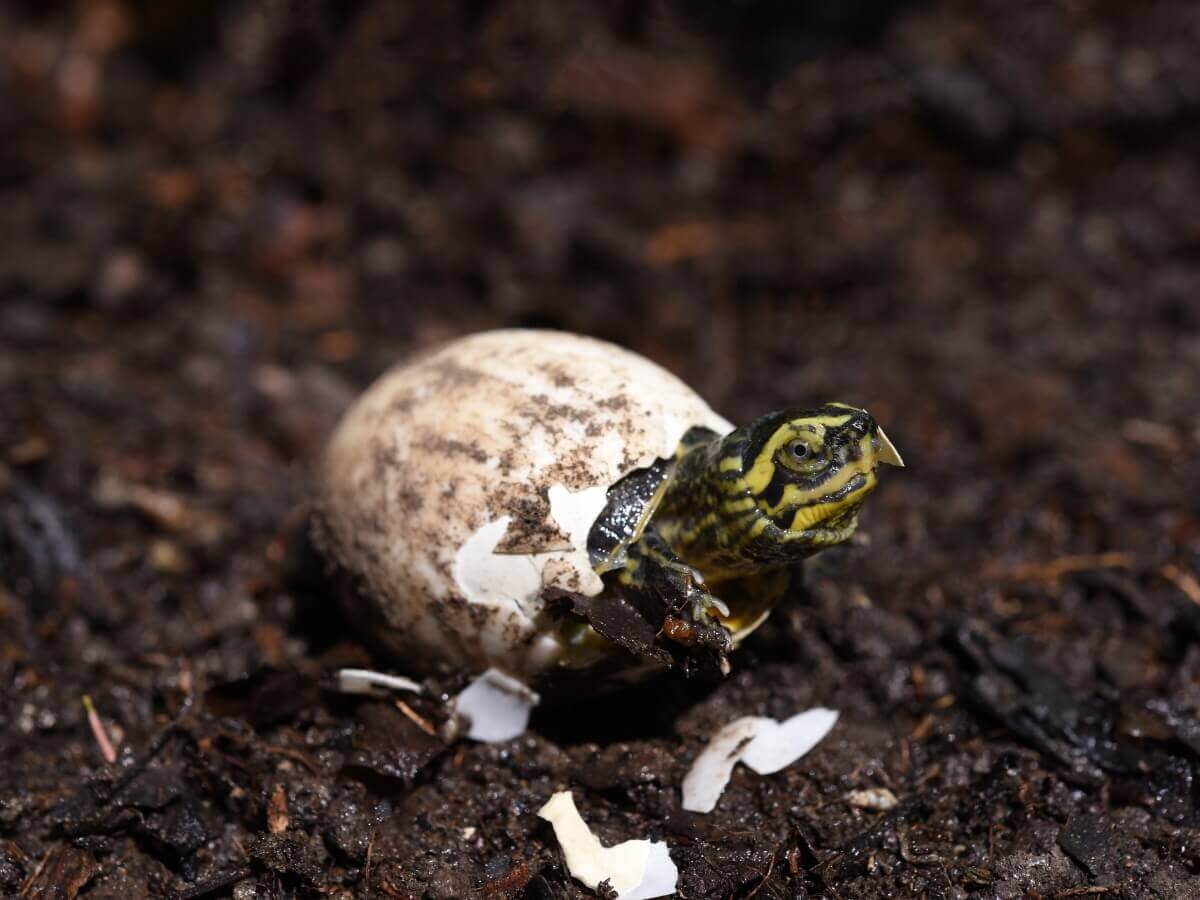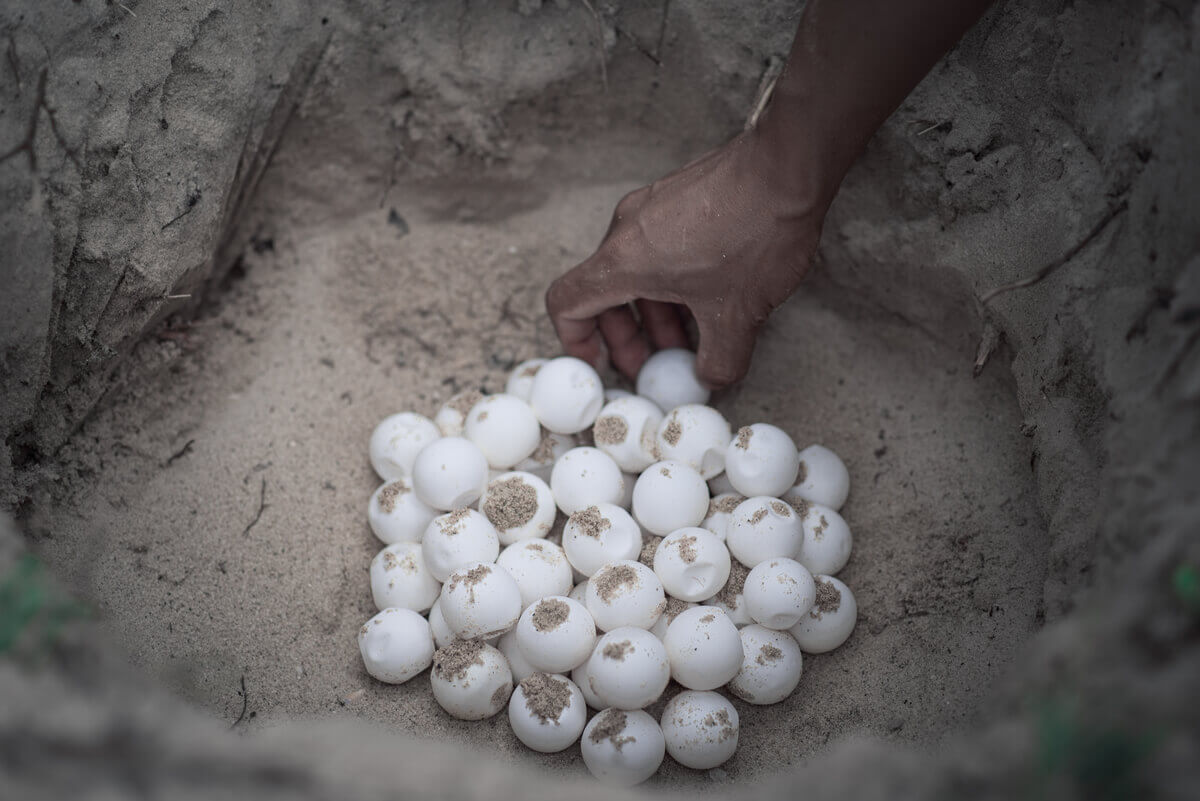How to Hatch Turtle Eggs

At present, several species of chelonians are at some degree of risk. For this reason, and as a method to help their subsistence, turtle eggs are artificially incubated. This process should only take place when the specimen lives in captivity, when the nest is destroyed or predated, and when artificial incubation ensures or increases the survival success of the animals.
Remember that only trained personnel should carry out these processes or, if that’s not possible, then the tutor should seek the advice of professionals. Although it may sound simple, one bad move could cost the baby its life. Therefore, in the following article, we’ll share some recommendations and warnings to hatch turtle eggs successfully.
What is artificial incubation?
Incubation is the process by which the eggs develop while the environment provides the necessary conditions such as temperature, humidity, and protection. In this sense, when the term “artificial” is added, it means that the hands of man will provide all the needs that the egg has to hatch.
Formally, this process refers to embryonic development, which forms the individual from small cells. Because it’s an important event in the makeup of the body, any abnormality that occurs can cause serious complications (and even death). This is why artificial incubation isn’t a tool that’s viable in all cases.

When is it good to use it?
Artificial incubation was born as a response to the danger that various turtles face. Therefore, what you seek is to maximize the number of hatches. This is because, in nature, there are too many threats that deplete the population of the specimens that require reintroduction.
Although most of them are living beings that damage species, droughts, storms, and other climatic phenomena can also affect them. It’s because of this that experts have created techniques to provide shelter for the eggs, preventing any external factor from causing their death.
Location and transport of eggs
First of all, we must emphasize that you should never remove turtle eggs from their natural nest unless they may be in imminent danger. This means that if you happen to come across a nest, the best option is to stay away and report it to the local authorities so they can follow up on it.
You may wonder why this is so important. The answer is that these shells are very fragile, as just a few movements can damage the embryo. In other words, the simple act of taking it in your hands can cause the embryo to become unviable. In other words, handling the eggs can cause the death of the developing turtle.
If for some strange reason you don’t get help (and if you leave the egg out in the open it will obviously die), then, as a last resort, you can try hatching it on your own. To do this, you’ll have to transport it to a safe place. Pick it up very carefully without turning it over and without moving it abruptly.
In fact, some people put a small marker on the shell to indicate out how they found it.
Transportation should take place using a hard-edged box, where movement will not cause the eggs to roll or flip. Also, remember to always place each egg in the same position as you found it on the ground.
Embryo verification
This is an extra step that only tells you whether or not the egg you rescued has an embryo. In other words, whether or not the turtle is likely to hatch. When performing this test, what you do is illuminate the shell with a lamp to check if there’s a small point with a network of veins, which reveals the embryo. During this process, it helps to make sure the flashlight has good lighting and that you do it in a dark room.
Incubation
For this step, you need to have an incubator. These machines are sold commercially, so you only need to assemble and connect them. This is always the best option, as one of the essential elements for hatching turtle eggs is to keep the temperature and humidity of the hatchlings constant.
When you get to the area where you’re going to incubate, the main thing is to have a good substrate, such as vermiculite, which absorbs moisture well and keeps the parameter constant. After getting it, you’ll moisten the substrate and bury the eggs in it, taking care that they don’t move too much. After that, place them in the incubator and keep them there until they hatch.
Parameters
Although it sounds simple, from here, the process is complicated, as you must be careful with the conditions inside the incubator. This means that you’ll have to monitor the temperature and humidity on a daily basis, to prevent the values from changing drastically. In fact, the incubation parameters vary between species, but we can reduce them to the following recommendations:
- Temperature: 82.4-89.6 ° F.
- Humidity: Soft shell eggs between 40 and 60% and hard shell eggs between 70 and 90%.
- Ventilation: Open (incubators have holes that ventilate the interior).
A very good option is to ask for help with the identification of the species, as this can give you specific clues about what the needs of the egg are. Also, as in crocodiles, keep in mind that temperature defines the sex of the young, so you should consider this point when hatching.

Can I build my own incubator?
The simple answer is yes. In fact, you don’t need many materials other than the substrate and some containers. To build an incubator, you only need 2 containers, one larger than the other, to make a kind of “water bath.” In this way, the small container remains floating inside the large one and you place a heater in the water to raise the temperature slightly.
The size of the incubator isn’t important, as long as you can put a lid on that encloses everything. Therefore, we recommend using a large container of approximately 20 liters, with a small container in which the eggs can fit. Remember that vermiculite also works in this case, as it has the same function as in the commercial incubator.
Finally, the entire home incubator must be an almost hermetic system, whose lid protects it from the outside. You can also replace it with aluminum foil that has perforations to let moisture out. In addition to all this, you should add a hygrometer and a thermometer to the container in order to monitor the temperature and humidity. In addition to this, consider refilling the water that evaporates.
Hatching
The incubation period is quite diverse between species, so you should be prepared to spend up to 115 days monitoring the incubator. However, once these creatures are born, you’ll realize that the effort is worth it.
Turtles hatch on their own, so right now, all you can do is watch. In fact, some turtles can take several hours or days to finish hatching, but despite this, you shouldn’t disturb or handle them. In addition, you may notice a small bag hanging from their belly (yolk), which you should not remove for any reason.
Once the first 2 days have passed, the process for hatching turtle eggs is over. As a result, the turtles reabsorb the yolk and are ready to leave the “nest”. At this time, the best option is to release them right in the area where you found them. If, on the other hand, the eggs come from your own pets, it’s preferable to keep the young in specialized terrariums.
What do turtle release groups do?
The main objective of these groups or associations is to protect sea turtles, as all of them are in some category of special protection. In fact, the process that these professionals carry out is different, as they don’t use commercial incubators, but instead make holes in the sand to simulate the original nest.
Thanks to this, they can protect the eggs until they hatch.
For the volunteers, incubating turtle eggs is mandatory, as they increase the number of specimens of each species that reach the sea. In addition, many experts advise them, so they’re always up to date on the best techniques and care for these chelonians.
What kind of turtle eggs can I hatch?
All the above recommendations are for hatching turtle eggs of any species. However, you’ll have to take into account the specific parameters that must be met to achieve their hatching. Remember that each type of turtle has different requirements, which will be essential to complete embryonic development.

In spite of everything, the best recommendation is to let the incubation occur in its natural habitat, as long as there are no factors that threaten the young. For this reason, artificial incubation is only an emergency method that serves to cope with imminent dangers to the species. Although anyone can carry it out, it must be done with great care and respect for animals.
All cited sources were thoroughly reviewed by our team to ensure their quality, reliability, currency, and validity. The bibliography of this article was considered reliable and of academic or scientific accuracy.
- Rangel-Mendoza, J., Weber, M., Hernández-García, J., & López-Luna, M. A. (2015). Manejo en cautiverio de la tortuga blanca (Dermatemys mawii Gray), estado actual e implicaciones para su conservación. AGRO, 249.
- Eckert, K. L., Bjorndal, K. A., Abreu-Grobois, F. A., & Donnelly, M. (2000). Técnicas de Investigación y Manejo para la Conservación de las Tortugas Marinas. Grupo especialista en tortugas marinas UICN/CSE Publicación, 4.
- Chacón, D., Sánchez, J., Calvo, J. J., & Ash, J. (2007). Manual para el manejo y la conservación de las tortugas marinas en Costa Rica; con énfasis en la operación de proyectos en playa y viveros. Sistema Nacional de Areas de Conservación, Ministerio de Ambiente y Energía, San José.
- Chacón, D., Dick, B., Harrison, E., Sarti, L., & Solano, M. (2008). Manual sobre técnicas de manejo y conservación de las tortugas marinas en playas de anidación de Centroamérica. Secretaría Pro Tempore de la Convención Interamericana para la Protección y Conservación de las Tortugas Marinas (CIT), San José, Costa Rica.
- Rana, C. A., Gachen, G., & Ceriani, C. (2016). Causas de retención de huevos en tortugas terrestres (Chelonoides chilensis). Universidad Nacional Del Centro de La Provincia de Buenos Aires. Tandil-Argentina, 18.
- Romito, M. L., Parachu Marco, M. V., & Imhof, A. (2015). Growth and reproduction of Chelonoidis chilensis (Reptilia, Testudinidae) in captivity.
- Arzola-González, J. F., Barrón-Hernández, J., Gutiérrez-Rubio, Y., Voltolina, D., & Ramírez-Pérez, J. S. (2019). Anidación e incubación artificial de huevos de tortuga golfina Lepidochelys olivacea (Testudines: Cheloniidae). Ecosistemas y recursos agropecuarios, 6(18), 595-599.
- Hernández, O., & Boede, E. O. (2008). Relación entre el tamaño de hembra y la producción de huevos en el morrocoy sabanero Geochelone (Chelonoidis) carbonaria (spix, 1824) en un zoocriadero comercial de Venezuela. Interciencia, 33(6), 461-466.
- Sarti, L., Huerta, P., Vasconcelos, D., Ocampo, E., Tavera, A., & Ángeles, M. A. (2006). Manual de técnicas de protección de tortugas marinas. Kutzari AC.
